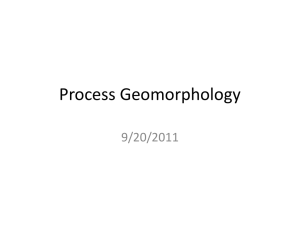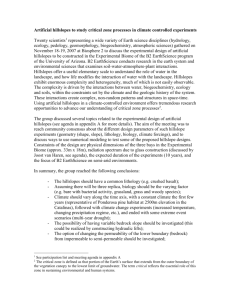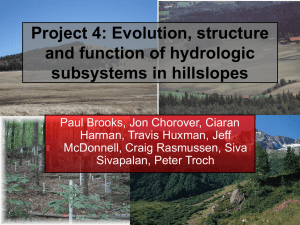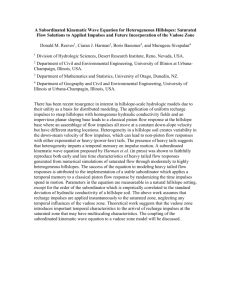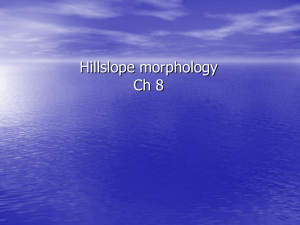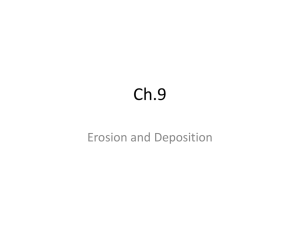Relax-a-Slope
advertisement
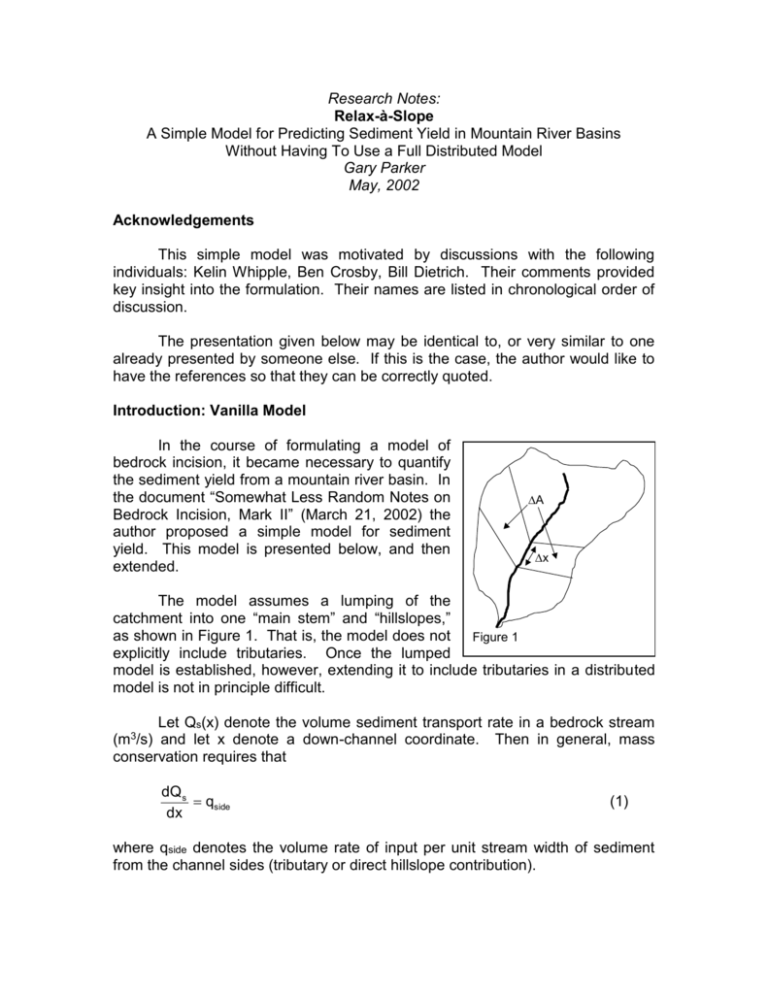
Research Notes: Relax-à-Slope A Simple Model for Predicting Sediment Yield in Mountain River Basins Without Having To Use a Full Distributed Model Gary Parker May, 2002 Acknowledgements This simple model was motivated by discussions with the following individuals: Kelin Whipple, Ben Crosby, Bill Dietrich. Their comments provided key insight into the formulation. Their names are listed in chronological order of discussion. The presentation given below may be identical to, or very similar to one already presented by someone else. If this is the case, the author would like to have the references so that they can be correctly quoted. Introduction: Vanilla Model In the course of formulating a model of bedrock incision, it became necessary to quantify the sediment yield from a mountain river basin. In the document “Somewhat Less Random Notes on Bedrock Incision, Mark II” (March 21, 2002) the author proposed a simple model for sediment yield. This model is presented below, and then extended. A x The model assumes a lumping of the catchment into one “main stem” and “hillslopes,” as shown in Figure 1. That is, the model does not Figure 1 explicitly include tributaries. Once the lumped model is established, however, extending it to include tributaries in a distributed model is not in principle difficult. Let Qs(x) denote the volume sediment transport rate in a bedrock stream and let x denote a down-channel coordinate. Then in general, mass conservation requires that (m3/s) dQ s qside dx (1) where qside denotes the volume rate of input per unit stream width of sediment from the channel sides (tributary or direct hillslope contribution). In the above-quoted document it was assumed that qside is simply determined by the incision rate EI of the stream itself. Let A(x) denotes the drainage area upstream of point x. If any streambed incision is assumed to propagate instantaneously up the hillslope, it follows that qsidex EIA (2a) or thus, as illustrated in Figure 1, qside EI dA EIBh dx (2b) where Bh dA dx (2c) defines an effective basin “width” (from divide to divide) at point x. Between the above relations it is found that dQs dA EI dx dx (3) The above equation gives a simple form for sediment yield in a drainage basin. In the case of a steady-state landscape undergoing uplift at the constant rate , it follows that EI is equal to , in which case (3) yields the result Qs A (4) Equation (3) is also able to capture sediment yield in a steady-state landscape for which is a function of x. In addition, it captures at least some features of non-steady-state evolution. In particular, in the case for which EI is not equal to , (3) allows the possibility for a sediment supply that changes as the nonsteady-state profile migrates upstream. Implicit in the model is the assumption that whereas perturbations take a finite amount of time to propagate up the channel, they propagate infinitely fast up the hillslopes (and by implication the tributaries). This is not accurate in general, but may be good enough for some purposes. Problems with Vanilla Model There are two main problems with the Vanilla Model of (3). The first is that it does not distinguish between hillslopes and tributary catchments. As pointed out above, this problem is easily remedied by extending the lumped model of Figure 1, with one “main stem” and the rest treated as hillslopes, to a distributed model that includes the tributaries. The second problem is not so easily remedied. According to (2b), when the incision rate falls to zero the sediment contribution from the sides drops to zero as well. This cannot be true in general, because even after the cessation of incision, hillslopes can contribute sediment to the channel by gradual lowering of hillslope relief due to hillslope diffusion, or, as it were, diffusive hillslope relaxation. With this in mind, Vanilla Model is generalized to Relax-à-Slope as a way to overcome this restriction. Relax-à-Slope Formulation Hillslopes are assumed to contribute sediment by two mechanisms; hillslope diffusion and landsliding. Hillslope diffusion is described in terms of a hillslope diffusivity (m2/s). Landsliding is described in terms of a limiting slope of the hillslopes hillslope Sl. Various parameters are defined in Figure 2. In particular, denotes elevation (e.g. on a hillslope). c denotes the elevation of the channel, e denotes the distance from the channel to the divide, and y denotes a coordinate following the hillslope drainage pattern from the divide to the channel, such that y = (1/2) Bh denotes the position of the channel. e channel y (1/2)Bh c Figure 2 The Exner equation of sediment conservation in the channel is (1 pb ) c EI t where t denotes time and pb denotes bedrock porosity (if any). equation of sediment conservation on the hillslope is q (1 ph ) h y t (5) The Exner (6) where ph denotes the porosity of the hillslope regolith and qh denotes the volume rate of transport of hillslope material down the hillslope per unit width (direction normal to the hillslope drainage pattern). Here the hillslope is assumed to have an “approximately” self-similar form; c fh ŷ , e ŷ y 1 Bh 2 (8) where fh is a “universal” function. An example is a simple linear function; fh 1 ŷ (9) Now (6) is integrated over the left hillslope in Figure 2; (1 ph ) (1/ 2 )Bh 0 (1/ 2 )Bh (1/ 2 )Bh q h dy (1 ph ) dy dy 0 0 t y (10) In order to complete the integration, it is assumed that is constant in y, qh = 0 at the ridge divide (y = 0) and Bh is constant in time (but not in x). Substituting (8) into (10) and performing the integration, it is found that 1 1 (1 ph ) Bh c h1 e (1 ph )Bn qhc 2 t t 2 (11) where qhc = qh at y = (1/2)Bh = the sediment supply rate to the channel per unit stream length, and h1 denotes an order-one dimensionless constant given by the relation 1 h1 fh ( ŷ)dŷ 0 (12) For example, in the case of the linear profile of (9) h1 =0.5. Equation (11) can be further reduced with the aid of (5) and the convenient assumption that pb = ph (which can be easily relaxed should one desire), resulting in the form 1 1 (1 ph )h1 Bh e BhEI qhc 2 t 2 An appropriate quantification for the slope of the hillslope S h is (13) Sh e 1 Bh 2 (14) in which case (13) can be recast as 2 1 dSh 1 (1 ph )h1 Bh BhEI qhc 2 2 dt (15) Hillslope Sediment Delivery Rate Assuming that the mechanism for the delivery of hillslope sediment is hillslope diffusion, it follows that qhc y y (1/ 2 )Bh (16) Here another implicit “similarity” assumption is introduced such that h2Sh y y (1/ 2 )Bh (17a) where h2 is another order-one dimensionless parameter, obtained from (8) as h2 dfh dŷ (17b) ŷ 1 .For example, for the linear profile of (9) h2 = 1. With (17a), (15) becomes 1 1 (1 ph )h1 Bh e BhEI h2 Sh 2 t 2 (18) Relax-à-Slope for Case of Hillslope Diffusion Substituting (14) into (18) allows the definition of a relation governing hillslope evolution: 2 1 Sh 1 (1 ph )h1 Bh BhEI h2 Sh 2 2 t Equation (15) can then be recast as (19) 2 1 1 Sh qhc BhEI (1 ph )h1 Bh 2 2 t (20) In the above formulation, the evolution of the hillslope is described using (19), and the sediment delivery to the channel is computed from (20). Remembering that qhc is the sediment delivery from the left side of the channel according to Figure 2, so that in (1) qside 2qhc (21) it follows from (19), (20) and (2c) that the extension of (3) is 2 dQs dA 1 dA Sh EI (1 ph )h1 dx dx 2 dx t (22) where 2 1 dA dSh dA (1 ph )h1 EI 2h2 Sh 2 dx t dx (23) Equations (22) and (23) allow for a steady-state solution for which dSh 0 dt dQs dA qside EI dx dx 1 EI dA Sh 2 h2 dx (24a,b,c) Note that (24b) reduces to exactly the same form as (4) under the assumption that EI = = a constant. The real strength of the new method appears when EI is allowed to vanish. In this case (22) and (23) reduce to dQ s 2h2 Sh dx (25) 2 1 dA Sh (1 ph )h1 2h2 Sh 2 dx t (26) That is, even in the absence of incision, sediment supply from the hillslopes does not fall to zero until Sh itself becomes vanishing. As the hillslopes relax under the effect of hillslope diffusion in the absence of incision, a supply of sediment that declines exponentially in time reaches the stream. Extension to Landsliding A very approximate extension of the formulation to encompass landsliding can be accomplished in the following way. Let S l denote the limiting (maximum) slope of the hillslope imposed by landsliding. One can assume that this limit is reached at sufficiently high rates of channel incision, i.e. so high that they drive repeated hillslope failure rather than diffusion. The simplest generalization of (19) that realizes this is the form B EI 1 Sh 1 (1 ph )h1 Bh BhEI h2 Sh 1 h 2 2 S 2 t h2 l (27) 2 In the limit of modest incision rates, or Bh EI 1 2 h2 Sl (28) (27) reduces to (19). On the other hand, in the limit of high incision rates, for which Bh EI 2 h2 Sl (29) (27) reduces to S 1 Sh 1 (1 ph )h1 Bh BhEI 1 h 2 Sl 2 t 2 (30) which has the steady-state solution Sh Sl In general, the steady-state solution is (31) Bh EI 2 h2 Sh Bh EI 1 2 h2 Sl (32) The Full Model The full model may thus be stated as 2 dQs dA 1 dA Sh EI (1 ph )h1 dx dx 2 dx t (33) 1 dA Sh dA 1 dA EI (1 ph )h1 EI 2h2 Sh 1 2 dx t dx 2 dx h2 Sl (34) 2 The order-one coefficients h1 and h2 are dimensionless, order-one parameters that can be specified for any given catchment based on field data, in accordance with the definitions (8) (12), (14) and (17).
